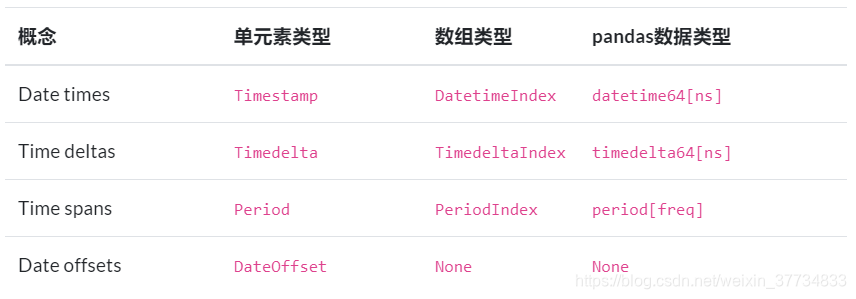文章目录
本周末期末考试 三门 需要复习 只能大概快速梳理一下了 写了下练习题 写的不全请见谅 之后会补上
一、时序中的基本对象
时间序列的概念在日常生活中十分常见,但对于一个具体的时序事件而言,可以从多个时间对象的角度来描述。例如2020年9月7日周一早上8点整需要到教室上课,这个课会在当天早上10点结束,其中包含了哪些时间概念?
-
第一,会出现时间戳(Date times)的概念,即’2020-9-7 08:00:00’和’2020-9-7 10:00:00’这两个时间点分别代表了上课和下课的时刻,在 pandas 中称为 Timestamp 。同时,一系列的时间戳可以组成 DatetimeIndex ,而将它放到 Series 中后, Series 的类型就变为了 datetime64[ns] ,如果有涉及时区则为 datetime64[ns, tz] ,其中tz是timezone的简写。
-
第二,会出现时间差(Time deltas)的概念,即上课需要的时间,两个 Timestamp 做差就得到了时间差,pandas中利用 Timedelta 来表示。类似的,一系列的时间差就组成了 TimedeltaIndex , 而将它放到 Series 中后, Series 的类型就变为了 timedelta64[ns] 。
-
第三,会出现时间段(Time spans)的概念,即在8点到10点这个区间都会持续地在上课,在 pandas 利用 Period 来表示。类似的,一系列的时间段就组成了 PeriodIndex , 而将它放到 Series 中后, Series 的类型就变为了 Period 。
-
第四,会出现日期偏置(Date offsets)的概念,假设你只知道9月的第一个周一早上8点要去上课,但不知道具体的日期,那么就需要一个类型来处理此类需求。再例如,想要知道2020年9月7日后的第30个工作日是哪一天,那么时间差就解决不了你的问题,从而 pandas 中的 DateOffset 就出现了。同时, pandas 中没有为一列时间偏置专门设计存储类型,理由也很简单,因为需求比较奇怪,一般来说我们只需要对一批时间特征做一个统一的特殊日期偏置。
通过这个简单的例子,就能够容易地总结出官方文档中的这个 表格 :

由于时间段对象 Period/PeriodIndex 的使用频率并不高,因此将不进行讲解,而只涉及时间戳序列、时间差序列和日期偏置的相关内容。
二、时间戳
1. Timestamp的构造与属性
单个时间戳的生成利用 pd.Timestamp 实现,一般而言的常见日期格式都能被成功地转换。
通过 year, month, day, hour, min, second 可以获取具体的数值。
在 pandas 中,时间戳的最小精度为纳秒 ns ,由于使用了64位存储,可以表示的时间范围大约可以如下计算:
T
i
m
e
R
a
n
g
e
=
2
64
1
0
9
×
60
×
60
×
24
×
365
≈
585
(
Y
e
a
r
s
)
\rm Time\,Range = \frac{2^{64}}{10^9\times 60\times 60\times 24\times 365} \approx 585 (Years)
TimeRange=109×60×60×24×365264≈585(Years)
通过 pd.Timestamp.max 和 pd.Timestamp.min 可以获取时间戳表示的范围。
2. Datetime序列的生成
一组时间戳可以组成时间序列,可以用 to_datetime 和 date_range 来生成。其中, to_datetime 能够把一列时间戳格式的对象转换成为 datetime64[ns] 类型的时间序列
3. dt对象
如同 category, string 的序列上定义了 cat, str 来完成分类数据和文本数据的操作,在时序类型的序列上定义了 dt 对象来完成许多时间序列的相关操作。这里对于 datetime64[ns] 类型而言,可以大致分为三类操作:取出时间相关的属性、判断时间戳是否满足条件、取整操作。
第一类操作的常用属性包括: date, time, year, month, day, hour, minute, second, microsecond, nanosecond, dayofweek, dayofyear, weekofyear, daysinmonth, quarter ,其中 daysinmonth, quarter 分别表示月中的第几天和季度。
4. 时间戳的切片与索引
一般而言,时间戳序列作为索引使用。如果想要选出某个子时间戳序列,第一类方法是利用 dt 对象和布尔条件联合使用,另一种方式是利用切片,后者常用于连续时间戳。
三、时间差
1. Timedelta的生成
正如在第一节中所说,时间差可以理解为两个时间戳的差,这里也可以通过 pd.Timedelta 来构造。
2. Timedelta的运算
四、日期偏置
1. Offset对象
2. 偏置字符串
五、时序中的滑窗与分组
1. 滑动窗口
所谓时序的滑窗函数,即把滑动窗口用 freq 关键词代替,下面给出一个具体的应用案例:在股票市场中有一个指标为 BOLL 指标,它由中轨线、上轨线、下轨线这三根线构成,具体的计算方法分别是 N 日均值线、 N 日均值加两倍 N 日标准差线、 N 日均值减两倍 N 日标准差线。
2. 重采样
重采样对象 resample 和第四章中分组对象 groupby 的用法类似,前者是针对时间序列的分组计算而设计的分组对象。
六、练习
Ex1:太阳辐射数据集
现有一份关于太阳辐射的数据集:

- 将 Datetime, Time 合并为一个时间列 Datetime ,同时把它作为索引后排序。
先看下表格什么样子:
df = pd.read_csv('data/solar.csv', usecols=['Data','Time',
'Radiation','Temperature'])
df.head(3)
| Data | Time | Radiation | Temperature | |
|---|---|---|---|---|
| 0 | 9/29/2016 12:00:00 AM | 23:55:26 | 1.21 | 48 |
| 1 | 9/29/2016 12:00:00 AM | 23:50:23 | 1.21 | 48 |
| 2 | 9/29/2016 12:00:00 AM | 23:45:26 | 1.23 | 48 |
利用正则表达式获取日期,将日期和时间合并成时间列。
这里正则表达式我没有和答案完全一样,答案给的是 ‘([/|\w]+\s).+’),个人觉得后面的.+好像没有必要,试了下对结果也没影响。
day_of_year=df.Data.str.extract(r'([/|\w]+)')[0]
df['Datetime']=pd.to_datetime(day_of_year +' '+ df.Time)
df.head(3)
| Data | Time | Radiation | Temperature | Datetime | |
|---|---|---|---|---|---|
| 0 | 9/29/2016 12:00:00 AM | 23:55:26 | 1.21 | 48 | 2016-09-29 23:55:26 |
| 1 | 9/29/2016 12:00:00 AM | 23:50:23 | 1.21 | 48 | 2016-09-29 23:50:23 |
| 2 | 9/29/2016 12:00:00 AM | 23:45:26 | 1.23 | 48 | 2016-09-29 23:45:26 |
然后再设置index及排序即可:
df.set_index('Datetime').sort_index(ascending=True).head(5)
| Data | Time | Radiation | Temperature | Datetime | |
|---|---|---|---|---|---|
| 0 | 9/29/2016 12:00:00 AM | 23:55:26 | 1.21 | 48 | 2016-09-29 23:55:26 |
| 1 | 9/29/2016 12:00:00 AM | 23:50:23 | 1.21 | 48 | 2016-09-29 23:50:23 |
| 2 | 9/29/2016 12:00:00 AM | 23:45:26 | 1.23 | 48 | 2016-09-29 23:45:26 |
| 3 | 9/29/2016 12:00:00 AM | 23:40:21 | 1.21 | 48 | 2016-09-29 23:40:21 |
| 4 | 9/29/2016 12:00:00 AM | 23:35:24 | 1.17 | 48 | 2016-09-29 23:35:24 |
这里忘记把原来的两列Data和Time删除了,使用drop删除:
df=df.drop(columns=['Data','Time']).
set_index('Datetime').sort_index(ascending=True)
| Datetime | Radiation | Temperature |
|---|---|---|
| 2016-09-01 00:00:08 | 2.58 | 51 |
| 2016-09-01 00:05:10 | 2.83 | 51 |
| 2016-09-01 00:20:06 | 2.16 | 51 |
| 2016-09-01 00:25:05 | 2.21 | 51 |
| 2016-09-01 00:30:09 | 2.25 | 51 |
- 每条记录时间的间隔显然并不一致,请解决如下问题:
a. 找出间隔时间的前三个最大值所对应的三组时间戳。
s = df.index.to_series().reset_index(drop=True).diff().dt.total_seconds()
max_3 = s.nlargest(3).index
df.index[max_3.union(max_3-1)]
# DatetimeIndex(['2016-09-29 23:55:26', '2016-10-01 00:00:19',
# '2016-11-29 19:05:02', '2016-12-01 00:00:02',
# '2016-12-05 20:45:53', '2016-12-08 11:10:42'],
# dtype='datetime64[ns]', name='Datetime', freq=None)
b. 是否存在一个大致的范围,使得绝大多数的间隔时间都落在这个区间中?如果存在,请对此范围内的样本间隔秒数画出柱状图,设置 bins=50 。
import matplotlib.pyplot as plt
res = s.mask((s>s.quantile(0.99))|(s<s.quantile(0.01)))
_ = plt.hist(res, bins=50)

3. 求如下指标对应的 Series :
a. 温度与辐射量的6小时滑动相关系数
res = df.Radiation.rolling('6H').corr(df.Temperature)
res.tail(3)
# Datetime
# 2016-12-31 23:45:04 0.328574
# 2016-12-31 23:50:03 0.261883
# 2016-12-31 23:55:01 0.262406
# dtype: float64
b.以三点、九点、十五点、二十一点为分割,该观测所在时间区间的温度均值序列
res = df.Temperature.resample('6H', origin='03:00:00').mean()
res.head()
# Datetime
# 2016-08-31 21:00:00 51.218750
# 2016-09-01 03:00:00 50.033333
# 2016-09-01 09:00:00 59.379310
# 2016-09-01 15:00:00 57.984375
# 2016-09-01 21:00:00 51.393939
# Freq: 6H, Name: Temperature, dtype: float64
c.每个观测6小时前的辐射量(一般而言不会恰好取到,此时取最近时间戳对应的辐射量)
my_dt = df.index.shift(freq='-6H')
int_loc = [df.index.get_loc(i, method='nearest') for i in my_dt]
res = df.Radiation.iloc[int_loc]
res.tail(3)
# Datetime
# 2016-12-31 17:45:02 9.33
# 2016-12-31 17:50:01 8.49
# 2016-12-31 17:55:02 5.84
# Name: Radiation, dtype: float64
Ex2:水果销量数据集
现有一份2019年每日水果销量记录表:

- 统计如下指标:
a. 每月上半月(15号及之前)与下半月葡萄销量的比值
df = pd.read_csv('data/fruit.csv')
df.Date = pd.to_datetime(df.Date)
df_grape = df.query("Fruit == 'Grape'")
res = df_grape.groupby([np.where(df_grape.Date.dt.day<=15,
'First', 'Second'),df_grape.Date.dt.month]
)['Sale'].mean().to_frame().unstack(0
).droplevel(0,axis=1)
res = (res.First/res.Second).rename_axis('Month')
res.head()
# Month
# 1 1.174998
# 2 0.968890
# 3 0.951351
# 4 1.020797
# 5 0.931061
# dtype: float64
b.每月最后一天的生梨销量总和
df[df.Date.dt.is_month_end].query("Fruit == 'Pear'"
).groupby('Date').Sale.sum().head()
# Date
# 2019-01-31 847
# 2019-02-28 774
# 2019-03-31 761
# 2019-04-30 648
# 2019-05-31 616
# Name: Sale, dtype: int64
c.每月最后一天工作日的生梨销量总和
df[df.Date.isin(pd.date_range('20190101', '20191231',
freq='BM'))].query("Fruit == 'Pear'"
).groupby('Date').Sale.mean().head()
# Date
# 2019-01-31 60.500000
# 2019-02-28 59.538462
# 2019-03-29 56.666667
# 2019-04-30 64.800000
# 2019-05-31 61.600000
# Name: Sale, dtype: float64
d.每月最后五天的苹果销量均值
target_dt = df.drop_duplicates().groupby(df.Date.drop_duplicates(
).dt.month)['Date'].nlargest(5).reset_index(drop=True)
res = df.set_index('Date').loc[target_dt].reset_index(
).query("Fruit == 'Apple'")
res = res.groupby(res.Date.dt.month)['Sale'].mean(
).rename_axis('Month')
res.head()
# Month
# 1 65.313725
# 2 54.061538
# 3 59.325581
# 4 65.795455
# 5 57.465116
# Name: Sale, dtype: float64
- 按月计算周一至周日各品种水果的平均记录条数,行索引外层为水果名称,内层为月份,列索引为星期。
month_order = ['January','February','March','April',
'May','June','July','August','September',
'October','November','December']
week_order = ['Mon','Tue','Wed','Thu','Fri','Sat','Sum']
group1 = df.Date.dt.month_name().astype('category').cat.reorder_categories(
month_order, ordered=True)
group2 = df.Fruit
group3 = df.Date.dt.dayofweek.replace(dict(zip(range(7),week_order))
).astype('category').cat.reorder_categories(
week_order, ordered=True)
res = df.groupby([group1, group2,group3])['Sale'].count().to_frame(
).unstack(0).droplevel(0,axis=1)
res.head()

- 按天计算向前10个工作日窗口的苹果销量均值序列,非工作日的值用上一个工作日的结果填
df_apple = df[(df.Fruit=='Apple')&(
~df.Date.dt.dayofweek.isin([5,6]))]
s = pd.Series(df_apple.Sale.values,
index=df_apple.Date).groupby('Date').sum()
res = s.rolling('10D').mean().reindex(
pd.date_range('20190101','20191231')).fillna(method='ffill')
res.head()
# 2019-01-01 189.000000
# 2019-01-02 335.500000
# 2019-01-03 520.333333
# 2019-01-04 527.750000
# 2019-01-05 527.750000
# Freq: D, dtype: float64





















 2476
2476











 被折叠的 条评论
为什么被折叠?
被折叠的 条评论
为什么被折叠?








